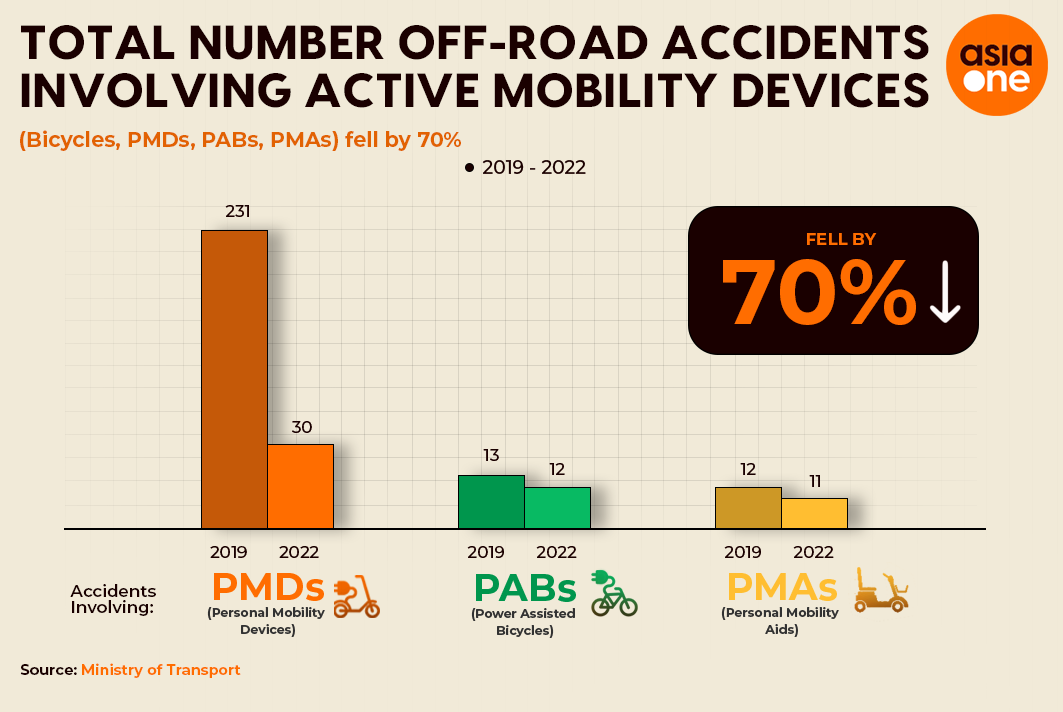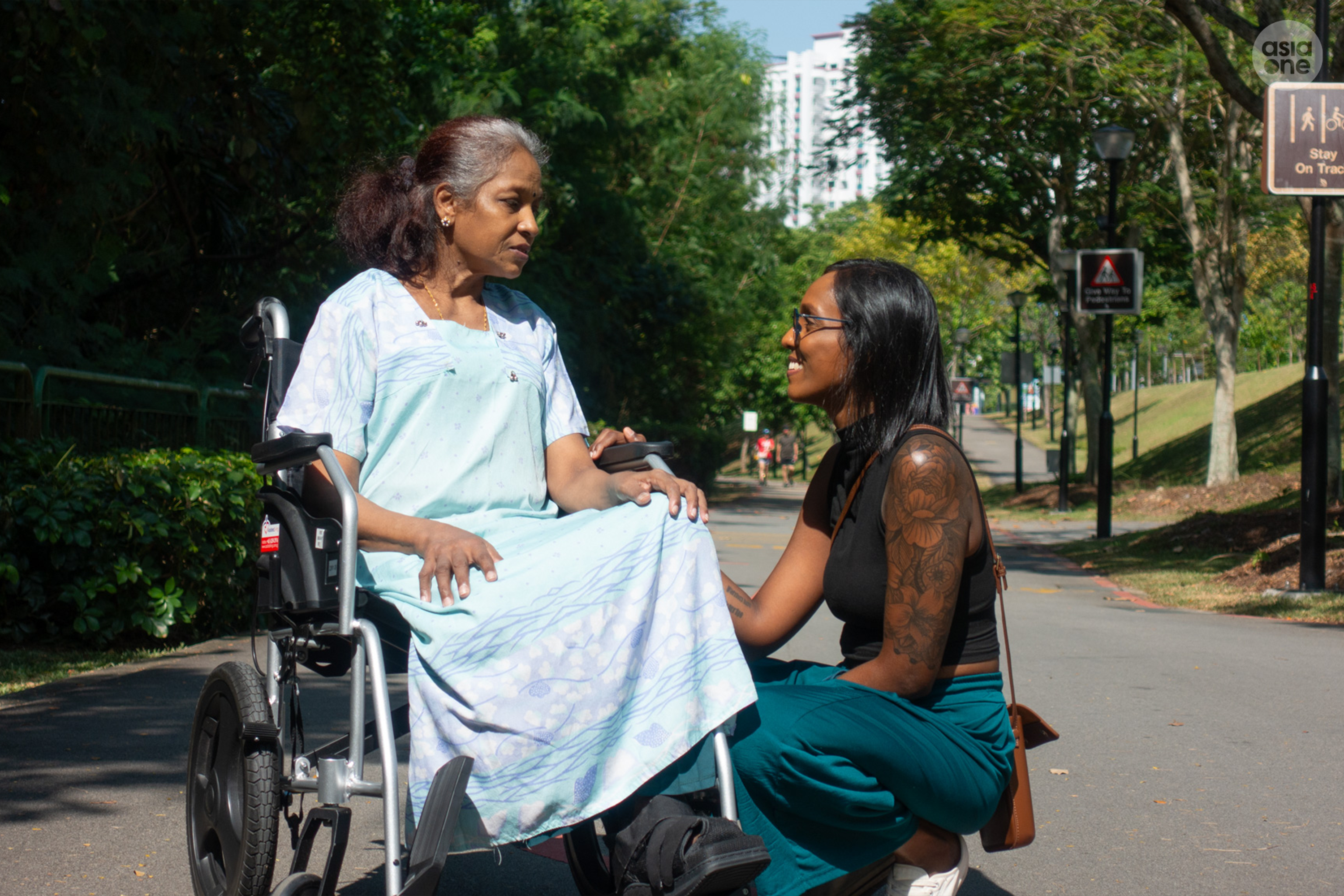
 PUBLISHED ONApril 11, 2024 9:00 AMBySophia KuekLynette Phua
PUBLISHED ONApril 11, 2024 9:00 AMBySophia KuekLynette Phua"Your grandfather's road ah?" This is a commonly heard phrase that carries more weight than its playful tone suggests. It reminds us that Singapore's paths and roads are in fact shared with many different types of users.
In the last decade or so, navigating these shared spaces wasn't as straightforward as today. Between November 2014 and October 2017, there was a 20 to 30 per cent surge in accidents involving Personal Mobility Devices (PMDs) according to a 2020 study by National Healthcare Group, prompting concerns and debates.

Examples of PMDs include electric scooters and hoverboards, while PMAs refer to personal mobility aids such as manual wheelchairs and mobility scooters.
Fast forward to today, with PMDs banned from footpaths since 2019, accidents on footpaths have plummeted by almost 70 per cent.

So, after five years, can we confidently say that our streets are safer?
To get a pulse on the matter, we took to the streets ourselves to hear from various path users - Personal Mobility Aid (PMA) users, cyclists and pedestrians. Here's what they had to say about the safety of Singapore's bustling pathways.
'There are all types of people out there'

If you visit The Marketplace at Block 58 in the Bedok district often, chances are you might have seen 75-year-old retiree Leo See Jum parked at the wet market, quietly observing passersby or running some errands.
Leo's poor circulation limits him from walking long distances, so he relies on the PMA to get around, granting him more independence.
"I can't walk - I can only go out using the PMA. It's more convenient for me now and I can also go on a bus while on it (PMA). I [am able to] take care of myself," shared Leo, who goes out on a little wander daily.
Fortunately, Leo doesn't encounter many obstacles on his commute to the nearby clinic or the market. Plus, he's keenly aware of PMA regulations, such as not riding out on main roads and riding at safe speeds - two practices that could keep himself and other path users safe.
That said, that doesn't mean his journeys have been entirely smooth - he has met a few pedestrians who completely disregard PMA users.
"There are all types of people out there. I once met a group of young punks who wanted to pick a fight with me," Leo recounted. "They asked, 'Horn what horn' and they refused to give way to me."
"It's difficult to reason with these people," shared Leo, adding that he just lets them go about their way first.
Leo's usual pace aligns well with the new recommended speed limit for PMAs of 6km/h sometime next year. The current speed limit for PMAs is 10km/h, which is equivalent to a run, and 6km/h is equivalent to a brisk walking speed.
"If the government were to reduce the speed limit for PMAs, it doesn't affect people like us," he shared, reiterating that he prefers to travel slowly anyway.
'Pathways can be dangerous if everyone is travelling at their maximum speed'

From a cycling enthusiast to a bicycle shop owner, 41-year-old Caleb Leong has had plenty of experience cycling on park connector networks (PCNs) as well as on the roads; however, in the last eight years that he has been cycling, he has had no bad experiences with sharing paths with other users.
His tactic? Riding during the non-peak hours.
"My usual routine would be to start the day early on weekdays, like at 5am, to best the morning traffic along the main roads. This lets me reach home by 7am. I typically avoid weekends as they are usually filled with the 'weekend cycling warriors'," shared Leong.
Despite typically only cycling during the non-peak hours, Leong often goes well prepared with safety gear and accessories, while also being mindful of when to give way.
"The road is public and should be shared graciously. My mates and I are usually very gracious in giving way and letting motorists and other path users know that we are there," said Leong, adding that he cycles on main roads and dedicated cycling lanes, like those along Tanah Merah coastal roads.
According to the Active Mobility Act, bicycles are allowed on roads, cycling paths and footpaths, but cyclists must wear helmets when riding on roads.
"Roads in Singapore are generally safe, but as some pathways are still quite narrow, it can get congested during the peak hours, and that's when it gets dangerous if everyone is travelling at their maximum speeds."
"PCN in parks, like East Coast Park, are typically ok, but PCN 'links' are the ones that can get crowded," added Leong, who also rides with his kids, aged three and six, at PCNs.
As such, Leong has made it his habit to 'think like a road user' on his cycling trips. This involves using hand signals to indicate his intentions to others and riding cautiously by always anticipating the traffic ahead.
These habits have served him well, affording the safety he enjoys while sharing footpaths and cycling paths with pedestrians, cyclists and PMA users. However, he agrees that there needs to be more regulations for safety and to prevent cases of the misuse of PMAs.
"They should have a genuine case for use. PMAs shouldn't be a mode of transport for able-bodied people," Leong emphasised.
'More people should try to empathise'

For the past six years, 33-year-old Vaduvkarasi has been taking care of her mother, Devi, who lost a limb due to diabetes.
As a freelance behavioural therapist, Karasi draws from her experience in her caregiving duties. Most of her beneficiaries are special needs children and youths, and some of them are physically disabled.
Karasi's compassionate nature and healthcare background are why she chooses to care for her mother herself. Instead of relying on a PMA for her mother's independence, they opted for a wheelchair instead.
"We didn't want to [get a PMA] because my mum's eyesight isn't very good anymore. We don't want her to get into any accidents," she explained. "I'd rather take care of her and bring her around."
Often, Karasi plans pleasant afternoons out with her mother, whether it's a wander along the riverside or a productive day running errands.
But these lovely outings can sometimes be ruined by errant pedestrians, cyclists and PMA users who have no regard for the safety of their fellow path users.
"Sometimes they come from behind and don't have bells. They don't signal to us," Karasi lamented. "Some cyclists cycle so fast, and they don't realise that some of the oncoming people are on wheelchairs."
Cyclists and electric scooters aren't the only dangers she's wary of. Distracted pedestrians can be potential hazards too, especially if they're on their phones while crossing the road.
"As a person who's pushing the wheelchair, it's a bit harder for me to suddenly move aside as compared to them," she explained. "I have to double check and be aware of what's in front or behind me all the time."
Despite encountering challenges, Karasi and her mother also experience moments of kindness from strangers. Courteous path users have noticed their presence and given way while a few have even offered friendly smiles and asked how her mother is doing.
"People should try to empathise, and not expect us to move and give way," Karasi hoped.
She believes that if path users could slow down and give way, Singapore's pavements could become much safer for her and her mother.
Paving the way to safer journeys
Often taken for granted, shared paths are used by many, some of whom, like Karasi and Caleb, have become anxious of sharing them.
Their experiences have underscored a need for graciousness amongst path users and bolstering the safety of Singapore's paths.
To safeguard the well-being of all path users, the Ministry of Transport (MOT) and the Land Transport Authority (LTA) have implemented many regulations and guidelines on paths and roads over the past few years, as well as campaigns on gracious path sharing to educate the public. In response to a rise in seemingly able-bodied people misusing PMAs, stricter regulations on PMA ownership and usage will also be implemented sometime next year.
However, while LTA carries out regular enforcement against errant path users, coupled with public education, it is ultimately - as Caleb and Karasi have also mentioned - the responsibility of every path user to play their part to be considerate and look out for one another so our paths can be safe for everyone.
This article is brought to you in partnership with the Ministry of Transport.
sophia.kuek@asiaone.com
No part of this story or photos can be reproduced without permission from AsiaOne.
